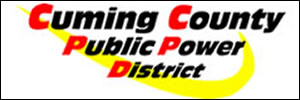
As a not-for-profit electric company, Cuming County Public Power District charges only what it costs to keep the lights on for our customers; rates are not marked up to generate profit. The directors and employees watch expenses carefully and are committed to providing electricity at the lowest possible cost.
Customers demand (KW) and energy (kWh) changes from month to month, but the monthly fee charge will stay the same. This charge covers the expenses to purchase, build and maintain power lines, substations and other equipment to ensure power is available at your location, whenever you need it.

Customer Charge
Covers the district’s fixed costs. This includes the costs of the meter, wires, poles, transformer, substations, customer services expenses, depreciation, administrative expenses (insurances) and line maintenance expenses. These are all fixed costs, meaning we pay even if there is zero kWh usage or 1,000 kWh usage.
Demand (KW) Charge
Demand (KW) is the rate at which you consume electricity, or the amount needed to power your service at any given point in time. For example, ten 100-watt lightbulbs use 1,000 watt-hours or 1 KW to operate. If you only have five 100-watt lightbulbs running, they use 500 watt-hours or 0.5 KW.
One way to control demand is not to run everything at once (such as the washer, dryer, stove, hair dryer, etc.). Stagger the load to keep it more even. The more things that are running, the more electricity (demand) is needed to run everything at once.
Energy (kWh)
Energy charge is the calculation of the amount of electricity (kWh) consumed during the billing period. For example, using our lightbulbs from above, if all ten lightbulbs are on for one hour, they have used 1 kWh of electricity (10 bulbs x 100 watts x1 hour = 1000 watt-hours or 1 kWh). If the billing period is 30 days those ten bulbs used 720 kWh. (10 bulbs x 100 watts x720 hours = 720,000 watt-hours or 720 kWh).

Explanation of Demand (kW) and Energy (kWh)
Electricity usage is measured in two ways:
- Demand (kW or kilowatts): the rate at which energy is used
- Energy (kWh or kilowatt-hours): the amount of energy used
Demand Charge (expressed as “kW” or “kilowatts”)
Demand, the rate at which a customer uses electricity during a specified time-period, is measured by the highest rate in that billing period.
Energy Charge (expressed as “kWh” or “kilowatt-hours”)
Energy charges are based on the amount of electricity a customer uses during the billing period which is expressed as kWh.
Think of it in terms of your car’s speedometer:

Example: Car travels at a rate of speed of 80 mph for ½ hour, the miles driven is only 40 miles.
In terms of electricity:
Customer’s rate of consumption is 80 kW for ½ hour, the kWh consumed is 40 kWh.
Understanding Demand and Consumption
The difference between demand and consumption is vital to your choices in reducing your energy costs. A simple way to see the difference between demand and consumption is by considering two examples.
One 100-watt light bulb burning for 10 hours consumes 1,000 watt-hours or 1 kWh. The entire time it is on, it requires or “demands” 100 watts or 0.1 kW from the utility. That means the utility must have that 0.1 kW ready whenever the customer turns the lamp on.

Similarly, ten 100-watt light bulbs burning for 1 hour consume 1,000 watt-hours or 1 kWh. Note that in both examples, the consumption is 1 kWh, however, look how differently the second situation impacts the utility from a demand perspective. The serving utility must now be prepared to provide ten times as much capacity in response to the “demand” of the 10 light bulbs operating all at once.
If both customers are billed for their consumption only, both will get the same bill for 1 kWh of energy. And that is the way most residential customers are billed. But the requirement for the utility to meet this energy requirement is very different. In the second case, the utility has to have 10 times more generating capacity to provide the second customer’s brief high demand for power compared to the first case.
Analogies for Understanding Demand and Consumption
Another way of understanding demand and consumption is with a “filling the bucket” analogy. Suppose you want to fill a 5-gallon bucket with water. You can use an inexpensive hose connection to your sink providing 1 gallon per minute to do it, and it will take 5 minutes. Or you can get a more expensive large faucet that provides 5 gallons per minute, it will fill in just one minute. The flow rate is equivalent to demand, and the 5 gallons of water are equivalent to consumption. In this example, filling both buckets has the same “consumption” but very different “demands.”

The same is true of electricity. While you may be able to accomplish the same thing by operating a small wattage appliance for many hours as operating something of higher wattage for just a few, the higher wattage piece of equipment will create a higher demand on the utility. Using our analogy, you are asking for a larger pipe, and that costs more. If time is of the essence, it might be worth having the more expensive high flow rate or wattage. This is why utilities often charge some customers for both demand and consumption. A customer that sets a high demand requires more services from the utility–additional generating plant capacity, and more expense in lines, transformers and substation equipment.



 500 S. Main Street
500 S. Main Street